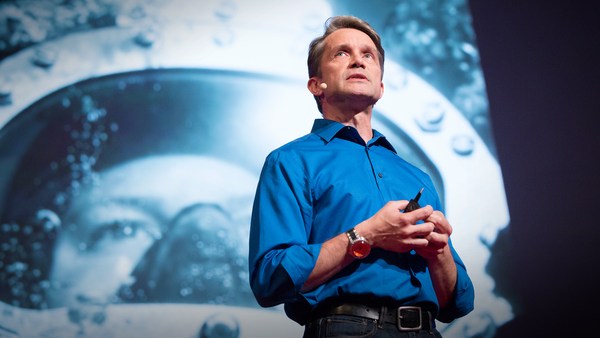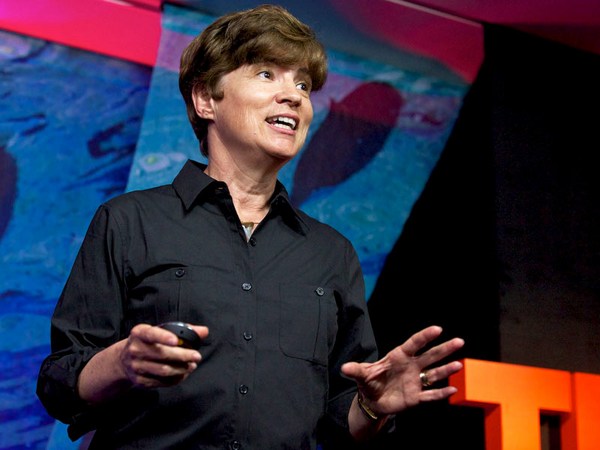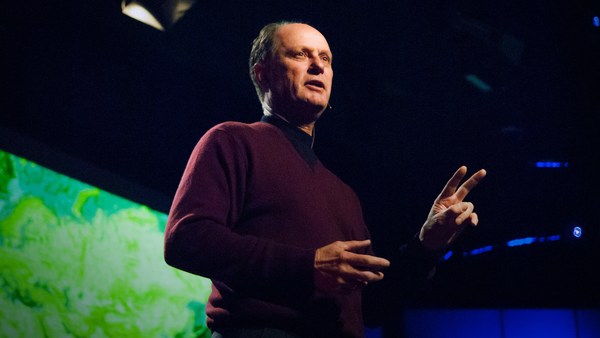I first became fascinated with octopus at an early age. I grew up in Mobile, Alabama -- somebody's got to be from Mobile, right? -- and Mobile sits at the confluence of five rivers, forming this beautiful delta. And the delta has alligators crawling in and out of rivers filled with fish and cypress trees dripping with snakes, birds of every flavor. It's an absolute magical wonderland to live in -- if you're a kid interested in animals, to grow up in. And this delta water flows to Mobile Bay, and finally into the Gulf of Mexico.
And I remember my first real contact with octopus was probably at age five or six. I was in the gulf, and I was swimming around and saw a little octopus on the bottom. And I reached down and picked him up, and immediately became fascinated and impressed by its speed and its strength and agility. It was prying my fingers apart and moving to the back of my hand. It was all I could do to hold onto this amazing creature. Then it sort of calmed down in the palms of my hands and started flashing colors, just pulsing all of these colors. And as I looked at it, it kind of tucked its arms under it, raised into a spherical shape and turned chocolate brown with two white stripes. I'm going, "My gosh!" I had never seen anything like this in my life! So I marveled for a moment, and then decided it was time to release him, so I put him down. The octopus left my hands and then did the damnedest thing: It landed on the bottom in the rubble and -- fwoosh! -- vanished right before my eyes.
And I knew, right then, at age six, that is an animal that I want to learn more about. So I did. And I went off to college and got a degree in marine zoology, and then moved to Hawaii and entered graduate school at the University of Hawaii. And while a student at Hawaii, I worked at the Waikiki Aquarium. And the aquarium had a lot of big fish tanks but not a lot of invertebrate displays, and being the spineless guy, I thought, well I'll just go out in the field and collect these wonderful animals I had been learning about as a student and bring them in, and I built these elaborate sets and put them on display.
Now, the fish in the tanks were gorgeous to look at, but they didn't really interact with people. But the octopus did. If you walked up to an octopus tank, especially early in the morning before anyone arrived, the octopus would rise up and look at you and you're thinking, "Is that guy really looking at me? He is looking at me!" And you walk up to the front of the tank. Then you realize that these animals all have different personalities: Some of them would hold their ground, others would slink into the back of the tank and disappear in the rocks, and one in particular, this amazing animal ... I went up to the front of the tank, and he's just staring at me, and he had little horns come up above his eyes. So I went right up to the front of the tank -- I was three or four inches from the front glass -- and the octopus was sitting on a perch, a little rock, and he came off the rock and he also came down right to the front of the glass. So I was staring at this animal about six or seven inches away, and at that time I could actually focus that close; now as I look at my fuzzy fingers I realize those days are long gone. Anyway, there we were, staring at each other, and he reaches down and grabs an armful of gravel and releases it in the jet of water entering the tank from the filtration system, and -- chk chk chk chk chk! -- this gravel hits the front of the glass and falls down. He reaches up, takes another armful of gravel, releases it -- chk chk chk chk chk! -- same thing. Then he lifts another arm and I lift an arm. Then he lifts another arm and I lift another arm. And then I realize the octopus won the arms race, because I was out and he had six left. (Laughter) But the only way I can describe what I was seeing that day was that this octopus was playing, which is a pretty sophisticated behavior for a mere invertebrate.
So, about three years into my degree, a funny thing happened on the way to the office, which actually changed the course of my life. A man came into the aquarium. It's a long story, but essentially he sent me and a couple of friends of mine to the South Pacific to collect animals for him, and as we left, he gave us two 16-millimeter movie cameras. He said, "Make a movie about this expedition." "OK, a couple of biologists making a movie -- this'll be interesting," and off we went. And we did, we made a movie, which had to be the worst movie ever made in the history of movie making, but it was a blast. I had so much fun. And I remember that proverbial light going off in my head, thinking, "Wait a minute. Maybe I can do this all the time. Yeah, I'll be a filmmaker." So I literally came back from that job, quit school, hung my filmmaking shingle and just never told anyone that I didn't know what I was doing. It's been a good ride. And what I learned in school though was really beneficial. If you're a wildlife filmmaker and you're going out into the field to film animals, especially behavior, it helps to have a fundamental background on who these animals are, how they work and, you know, a bit about their behaviors.
But where I really learned about octopus was in the field, as a filmmaker making films with them, where you're allowed to spend large periods of time with the animals, seeing octopus being octopus in their ocean homes. I remember I took a trip to Australia, went to an island called One Tree Island. And apparently, evolution had occurred at a pretty rapid rate on One Tree, between the time they named it and the time I arrived, because I'm sure there were at least three trees on that island when we were there. Anyway, one tree is situated right next to a beautiful coral reef. In fact, there's a surge channel where the tide is moving back and forth, twice a day, pretty rapidly. And there's a beautiful reef, very complex reef, with lots of animals, including a lot of octopus. And not uniquely but certainly, the octopus in Australia are masters at camouflage. As a matter of fact, there's one right there. So our first challenge was to find these things, and that was a challenge, indeed. But the idea is, we were there for a month and I wanted to acclimate the animals to us so that we could see behaviors without disturbing them. So the first week was pretty much spent just getting as close as we could, every day a little closer, a little closer, a little closer. And you knew what the limit was: they would start getting twitchy and you'd back up, come back in a few hours. And after the first week, they ignored us. It was like, "I don't know what that thing is, but he's no threat to me." So they went on about their business and from a foot away, we're watching mating and courting and fighting and it is just an unbelievable experience.
And one of the most fantastic displays that I remember, or at least visually, was a foraging behavior. And they had a lot of different techniques that they would use for foraging, but this particular one used vision. And they would see a coral head, maybe 10 feet away, and start moving over toward that coral head. And I don't know whether they actually saw crab in it, or imagined that one might be, but whatever the case, they would leap off the bottom and go through the water and land right on top of this coral head, and then the web between the arms would completely engulf the coral head, and they would fish out, swim for crabs. And as soon as the crabs touched the arm, it was lights out. And I always wondered what happened under that web. So we created a way to find out, (Laughter) and I got my first look at that famous beak in action. It was fantastic.
If you're going to make a lot of films about a particular group of animals, you might as well pick one that's fairly common. And octopus are, they live in all the oceans. They also live deep. And I can't say octopus are responsible for my really strong interest in getting in subs and going deep, but whatever the case, I like that. It's like nothing you've ever done.
If you ever really want to get away from it all and see something that you have never seen, and have an excellent chance of seeing something no one has ever seen, get in a sub. You climb in, seal the hatch, turn on a little oxygen, turn on the scrubber, which removes the CO2 in the air you breathe, and they chuck you overboard. Down you go. There's no connection to the surface apart from a pretty funky radio. And as you go down, the washing machine at the surface calms down. And it gets quiet. And it starts getting really nice. And as you go deeper, that lovely, blue water you were launched in gives way to darker and darker blue. And finally, it's a rich lavender, and after a couple of thousand feet, it's ink black. And now you've entered the realm of the mid-water community.
You could give an entire talk about the creatures that live in the mid-water. Suffice to say though, as far as I'm concerned, without question, the most bizarre designs and outrageous behaviors are in the animals that live in the mid-water community. But we're just going to zip right past this area, this area that includes about 95 percent of the living space on our planet and go to the mid-ocean ridge, which I think is even more extraordinary.
The mid-ocean ridge is a huge mountain range, 40,000 miles long, snaking around the entire globe. And they're big mountains, thousands of feet tall, some of which are tens of thousands of feet and bust through the surface, creating islands like Hawaii. And the top of this mountain range is splitting apart, creating a rift valley. And when you dive into that rift valley, that's where the action is because literally thousands of active volcanoes are going off at any point in time all along this 40,000 mile range. And as these tectonic plates are spreading apart, magma, lava is coming up and filling those gaps, and you're looking land -- new land -- being created right before your eyes. And over the tops of them is 3,000 to 4,000 meters of water creating enormous pressure, forcing water down through the cracks toward the center of the earth, until it hits a magma chamber where it becomes superheated and supersaturated with minerals, reverses its flow and starts shooting back to the surface and is ejected out of the earth like a geyser at Yellowstone. In fact, this whole area is like a Yellowstone National Park with all of the trimmings.
And this vent fluid is about 600 or 700 degrees F. The surrounding water is just a couple of degrees above freezing. So it immediately cools, and it can no longer hold in suspension all of the material that it's dissolved, and it precipitates out, forming black smoke. And it forms these towers, these chimneys that are 10, 20, 30 feet tall. And all along the sides of these chimneys is shimmering with heat and loaded with life. You've got black smokers going all over the place and chimneys that have tube worms that might be eight to 10 feet long. And out of the tops of these tube worms are these beautiful red plumes. And living amongst the tangle of tube worms is an entire community of animals: shrimp, fish, lobsters, crab, clams and swarms of arthropods that are playing that dangerous game between over here is scalding hot and freezing cold.
And this whole ecosystem wasn't even known about until 33 years ago. And it completely threw science on its head. It made scientists rethink where life on Earth might have actually begun. And before the discovery of these vents, all life on Earth, the key to life on Earth, was believed to be the sun and photosynthesis. But down there, there is no sun, there is no photosynthesis; it's chemosynthetic environment down there driving it, and it's all so ephemeral. You might film this unbelievable hydrothermal vent, which you think at the time has to be on another planet. It's amazing to think that this is actually on earth; it looks like aliens in an alien environment. But you go back to the same vent eight years later and it can be completely dead. There's no hot water. All of the animals are gone, they're dead, and the chimneys are still there creating a really nice ghost town, an eerie, spooky ghost town, but essentially devoid of animals, of course. But 10 miles down the ridge... pshhh! There's another volcano going. And there's a whole new hydrothermal vent community that has been formed. And this kind of life and death of hydrothermal vent communities is going on every 30 or 40 years all along the ridge.
And that ephemeral nature of the hydrothermal vent community isn't really different from some of the areas that I've seen in 35 years of traveling around, making films. Where you go and film a really nice sequence at a bay. And you go back, and I'm at home, and I'm thinking, "Okay, what can I shoot ... Ah! I know where I can shoot that. There's this beautiful bay, lots of soft corals and stomatopods." And you show up, and it's dead. There's no coral, algae growing on it, and the water's pea soup. You think, "Well, what happened?" And you turn around, and there's a hillside behind you with a neighborhood going in, and bulldozers are pushing piles of soil back and forth. And over here there's a golf course going in. And this is the tropics. It's raining like crazy here. So this rainwater is flooding down the hillside, carrying with it sediments from the construction site, smothering the coral and killing it. And fertilizers and pesticides are flowing into the bay from the golf course -- the pesticides killing all the larvae and little animals, fertilizer creating this beautiful plankton bloom -- and there's your pea soup.
But, encouragingly, I've seen just the opposite. I've been to a place that was a pretty trashed bay. And I looked at it, just said, "Yuck," and go and work on the other side of the island. Five years later, come back, and that same bay is now gorgeous. It's beautiful. It's got living coral, fish all over the place, crystal clear water, and you go, "How did that happen?" Well, how it happened is the local community galvanized. They recognized what was happening on the hillside and put a stop to it; enacted laws and made permits required to do responsible construction and golf course maintenance and stopped the sediments flowing into the bay, and stopped the chemicals flowing into the bay, and the bay recovered. The ocean has an amazing ability to recover, if we'll just leave it alone.
I think Margaret Mead said it best. She said that a small group of thoughtful people could change the world. Indeed, it's the only thing that ever has. And a small group of thoughtful people changed that bay. I'm a big fan of grassroots organizations. I've been to a lot of lectures where, at the end of it, inevitably, one of the first questions that comes up is, "But, but what can I do? I'm an individual. I'm one person. And these problems are so large and global, and it's just overwhelming." Fair enough question.
My answer to that is don't look at the big, overwhelming issues of the world. Look in your own backyard. Look in your heart, actually. What do you really care about that isn't right where you live? And fix it. Create a healing zone in your neighborhood and encourage others to do the same. And maybe these healing zones can sprinkle a map, little dots on a map. And in fact, the way that we can communicate today -- where Alaska is instantly knowing what's going on in China, and the Kiwis did this, and then over in England they tried to ... and everybody is talking to everyone else -- it's not isolated points on a map anymore, it's a network we've created. And maybe these healing zones can start growing, and possibly even overlap, and good things can happen. So that's how I answer that question. Look in your own backyard, in fact, look in the mirror. What can you do that is more responsible than what you're doing now? And do that, and spread the word. The vent community animals can't really do much about the life and death that's going on where they live, but up here we can. In theory, we're thinking, rational human beings. And we can make changes to our behavior that will influence and affect the environment, like those people changed the health of that bay.
Now, Sylvia's TED Prize wish was to beseech us to do anything we could, everything we could, to set aside not pin pricks, but significant expanses of the ocean for preservation, "hope spots," she calls them. And I applaud that. I loudly applaud that. And it's my hope that some of these "hope spots" can be in the deep ocean, an area that has historically been seriously neglected, if not abused. The term "deep six" comes to mind: "If it's too big or too toxic for a landfill, deep six it!" So, I hope that we can also keep some of these "hope spots" in the deep sea. Now, I don't get a wish, but I certainly can say that I will do anything I can to support Sylvia Earle's wish. And that I do.
Thank you very much. (Applause)





